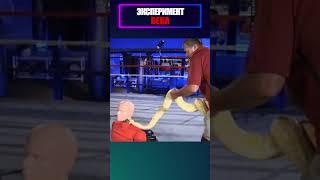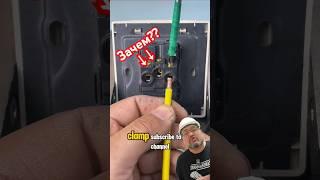
How To Use Transistors In YOUR Projects! || Transistors Explained || Transistors As A Switch
Комментарии:

I don't get it why it lights. The current travels to the other cable not the one with the led
Ответить
Just watched your video, excellent
Ответить
So... As per the video, you set up the NPN circuit
However this is made redundant because you just use the tactile swtich and there is no need for the transistor.
You said...
You can use a Micro like an Arduino or whatever, OK
but with a an Arduino you still don't need the transistor because you toggle an LED on and off anyway
the transistor is still redundant
Here is what i want to know
in a SMPS on the input stage at the switching stage of the Power supply after the input power has passed the bridge rectifier,
the input is DC , it Now it needs to pass through the transformer but as DC it cannot do that , so ENTER OUR TRANSISTOR (MOSFET), the current passes through the MOSFET and SWITCHES ON AND OFF AT HIGH FREQUENCY thus allowing AC to pass through the Transformer
There is no Arduino here, there is no micro controller, i would like to set up this circuit,
Now, there is a PWM controller, although this is only for the feedback loop and ASSUMING THERE ARE NO ERRORS OR INRUSH (in a perfect world) i believe the PWM is not necessary
it should really only be the voltage from the caps going into the MOSFETS and then the MOSFETS doing the switching.
so.. without probing the hot side of a SMPS and blowing my scope since i don't own a set of isolation probes.
How would i hook up an NPN so that i can observe on my scope the high frequency switching that it exhibits ?
this would make the transistor viable

Awesome explanation. You answered my question I had in mind at the end of this video.
Ответить
That thing you called a switch was a push button
Ответить
Good one. Hwow about North. Points North and Never points North ? Compasses can be visualised that way. Thanks.
Ответить
BC 548 general purpose npn transistor.
What number is Pnp transistor ?

Thank you for using a visual explanation, this helped me a lot!!
Ответить
good video
Ответить
I just remember the P (p)oints to N, and then fill in the missing value.
Ответить
Why don't you people show us how to use transistor has a tooth pick because you sure don't no how to use it in electronic circuit this video is showing us how to use a transistor as a conductor not a switch
Ответить
Great way of teaching well done
Ответить
My question is if always it has to be a finger or relay involved to press the switch, how transistors switch themselves on and off thousands times per minute?
Ответить
I have watched scores of videos trying to understand. Thank you. This is the best. It's like you were reading my mind.
Ответить
Saturation!!!!
Ответить
This is a fantastic video! So simple and clear.
Thank you for sharing your knowledge and talents.

Everything is fine ! But if you have a microcontroller like an arduino you can eazally do that automatic flip flop LED without the transistors.
Ответить
What is the purpose of resistor in the circuit.
Ответить
Very clear and simple explanation of transistors.
Ответить
This is it how to use a transistor this is just dumb
Ответить
Current flow from negative to positive😢😢
Ответить
As a kid I got interested in electronics seeing my uncle use a springboard kit, but every time I asked how a transistor worked he gave me some non-sence different answer that left me confused all my life about them (my uncle is a major jerk), I'm almost 58 now, and disabled due to a stroke, and your video finally explained it to me in a way that makes sense.. Thank you.
Ответить
You are a good teacher!
Ответить
Conventional current or electron current?
Which is true?

at the end of material You said main reason why the heck transistors are so important - swiching higher frequencies. By the way it was best explanation (for me) what transistor realy do, at you tube.
Ответить
Easy explanation. Thanks.
Ответить
As an electronics engineer I like this!
Ответить
Thank you
Ответить
So, with NPN, the BASE gets a positive current to turn on, the COLLECTOR goes to the power supply and the EMMITER goes to the load? Trying to learn from scratch, but no one seems to use the correct names for the legs. Not all transistors use the same configuration. I keep killing transistors
Ответить
The clearest practical and theoretical explanation I found.
Ответить
When thinking about polarity of Base inputs, it helps to take the middle letter has a reminder, for example PNP, the middle letter is N-for negative to switch on. And the NPN has the letter P- for positive to turn on.
And for those who were thinking whats the point, wet your fingers slightly and touch the base lead and the battery, the transistor will turn on with the tiny current passing through your body, also try connecting a Photocell inline with the base resistor, these experiments will convince you.

Thank you! Finally, a very simple explanation. I was actually able to create the same circuit and it worked.
Ответить
One thing I really hate is that instead of having one unified understanding of electricity, we seperate electron flow from current flow... and for those that are barely starting they're going to mess up or destroy so many projects because of this... some ppl even get confused after learning current flow and take that as bible when connecting battery terminals on their vehicle and do major damage... I wish this was fixed to just be electron flow so ppl can stop doing shit like that.
Ответить
I have been trying to understand transistors for days and this is the one that made it click haha!
Ответить
"...of course it does..." Haha, thank you!
Ответить
FINALY!!!! Someone who actually makes it make sense. Thank you for the practical application and for answering the question I had (why use a transistor if you can just use a switch). Suscribing to learn more. Thank you!
Ответить
I did it like you said but my LED always stay on and when i press the switch it gets brighter
Ответить
Love it .
subscribed .
Now i know how they work .

Thank-you so much for recognising visual learners.
Ответить
But why do you need to types of transistors , NPN vs PNP ? PNP you would use perhaps, if you have primarily negative charges, that you want to amplify, like muscular responses of the body ?
Ответить
Ah you don't know how to use transistors I wish people would stop posting the stupid videos all they do is waste every body time and these comments claiming this is a great video I got the feeling they are fake comments
Ответить
Fantastic video! Thanks!
Ответить
Great information…..thank you
Ответить
How to use a npn and pnp great
Ответить
Excellent explanation thanks
Ответить
Seems like a waste. All you need is a switch, not a switch and a pretend switch. I just see extra unnecessary components.
Ответить
Very nicely explained
Ответить
Thank you for this great introductory video regarding Transistors, please post more,🙂
Ответить
Stop this crap
Ответить
I know transistors are probably the most important electronic component, but I have a question derived from your answer to the question at the end: why use them for that circuit that lights up one of the two LEDs at a time? Why not connect the LEDds directly to the microcontroler (which would be programmed to send voltage to one of the LEDs at a time)?
Excelent video! Very well explained.


























